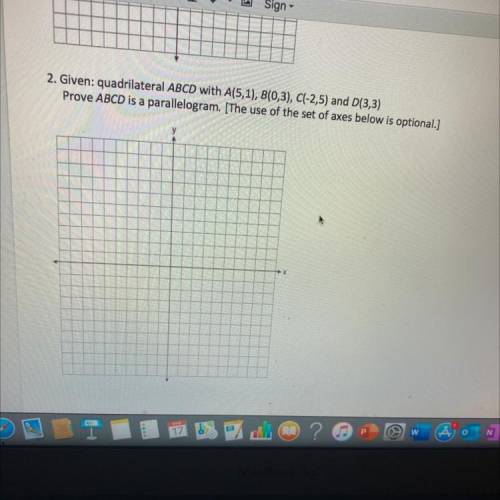
Mathematics, 18.03.2021 03:30 alex43079
2. Given: quadrilateral ABCD with A(5,1), B(0,3), C (-2,5) and D(3,3)
Prove ABCD is a parallelogram. (The use of the set of axes below is optional.]
X


Answers: 2


Another question on Mathematics

Mathematics, 21.06.2019 15:30
Asquare is dilated by a scale factor of 1.25 to create a new square. how does the area of the new square compare with the area of the original square? a)the area of the new square is 1.25 times the area of the original square. b)the area of the new square is 2.50 times the area of the original square. c)the area of the new square is 1.252 times the area of the original square. d)the area of the new square is 1.253 times the area of the original square.
Answers: 1

Mathematics, 21.06.2019 18:00
Sara can take no more than 22 pounds of luggage on a trip.her suitcase weighs 112 ounces.how many more pounds can she pack without going over the limit?
Answers: 1

Mathematics, 21.06.2019 18:30
Which equation represents the model shown? a)1/3 divide 1/6 = 2 b)2/3 divide 1/6 = 2/18 c)1/3 divide 1/6 = 1/18 d)2/3 divide 1/6 =4
Answers: 1

Mathematics, 21.06.2019 19:00
What are the solutions of the system? solve by graphing. y = x^2 + 3x + 2 y = 2x + 2
Answers: 1
You know the right answer?
2. Given: quadrilateral ABCD with A(5,1), B(0,3), C (-2,5) and D(3,3)
Prove ABCD is a parallelogram...
Questions







Mathematics, 19.07.2019 11:40


Mathematics, 19.07.2019 11:40

Mathematics, 19.07.2019 11:40

History, 19.07.2019 11:40


Mathematics, 19.07.2019 11:40





Social Studies, 19.07.2019 11:40


English, 19.07.2019 11:40



